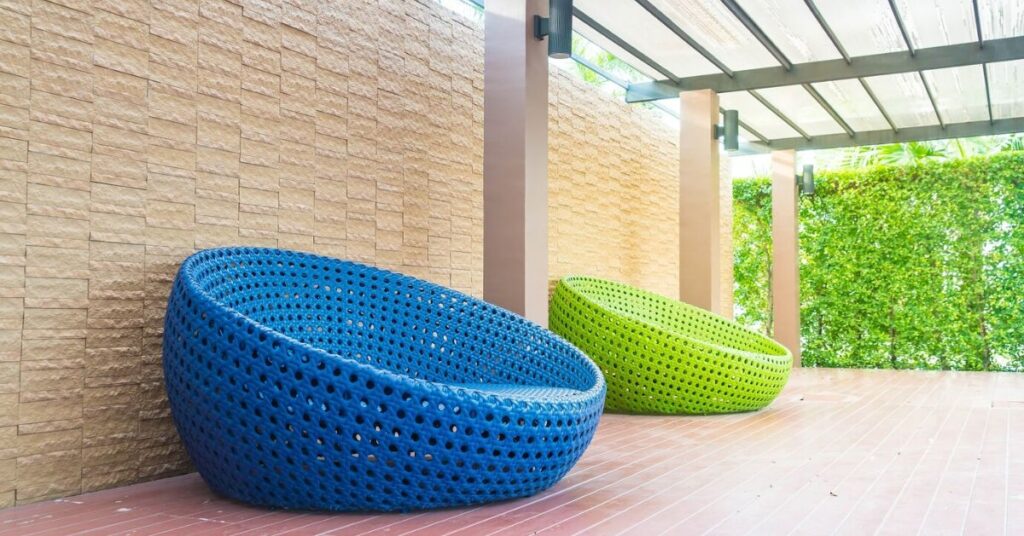When it comes to furnishing your outdoor space, wicker patio furniture is a timeless choice. Its classic woven design adds elegance and comfort to any patio, deck, or garden. However, one major decision you’ll face is whether to choose synthetic (resin) wicker or natural wicker (rattan, bamboo, or reed).
Both options have their pros and cons, and the best choice depends on your climate, maintenance preferences, budget, and style. In this guide, we’ll compare synthetic vs. natural wicker patio furniture to help you decide which one is right for your outdoor living space.
What Is Wicker Furniture?
Wicker refers to the weaving technique used to create furniture, not the material itself. Wicker furniture can be made from:
- Natural materials (rattan, bamboo, cane, willow, or reed)
- Synthetic materials (resin, PVC, or polyethylene)
Now, let’s dive into the differences between synthetic and natural wicker.
- Natural Wicker Patio Furniture
Pros of Natural Wicker
✅ Eco-Friendly & Biodegradable – Made from renewable plant materials like rattan and bamboo.
✅ Authentic Aesthetic – Offers a warm, organic, and high-end look that synthetic wicker can’t fully replicate.
✅ Breathable & Lightweight – More comfortable in hot weather since it doesn’t trap heat like plastic.
✅ Softer Texture – Feels more natural to the touch compared to synthetic alternatives.
Cons of Natural Wicker
❌ Not Weather-Resistant – Prone to fading, cracking, and mold when exposed to rain, humidity, or UV rays.
❌ High Maintenance – Requires regular sealing, varnishing, or storage during harsh weather.
❌ Shorter Lifespan – Typically lasts 3-5 years outdoors unless well-protected.
❌ Limited Outdoor Use – Best suited for covered patios or screened-in porches rather than open-air spaces.
Best For:
- Homeowners in dry, mild climates
- Those who prefer natural, rustic aesthetics
- People willing to maintain and store furniture seasonally
- Synthetic (Resin) Wicker Patio Furniture
Pros of Synthetic Wicker
✅ Extremely Durable – Resistant to UV rays, moisture, mold, and insects, making it ideal for outdoor use.
✅ Low Maintenance – Only needs occasional cleaning with soap and water.
✅ Long Lifespan – Can last 10+ years without significant wear.
✅ All-Weather Use – Perfect for rainy, humid, or sunny climates.
✅ Lightweight Yet Sturdy – Easier to move than natural wicker but still strong.
✅ Wide Variety of Colors & Styles – Available in modern weaves and fade-resistant hues.
Cons of Synthetic Wicker
❌ Less Authentic Look – Some resin wicker can appear plastic-like.
❌ Can Get Hot in Sun – Retains more heat than natural fibers.
❌ Not Biodegradable – Made from plastic (HDPE or PVC), which isn’t eco-friendly.
❌ Higher Initial Cost – Premium synthetic wicker sets can be pricier than natural options.
Best For:
- Homeowners in rainy, humid, or extremely sunny areas
- Those who want low-maintenance, long-lasting furniture
- People who prefer modern, sleek designs
Key Differences: Synthetic vs. Natural Wicker
| Feature | Natural Wicker | Synthetic Wicker |
| Material | Rattan, bamboo, reed | Resin (HDPE, PVC) |
| Durability | 3-5 years (outdoors) | 10+ years |
| Weather Resistance | Poor (needs protection) | Excellent (UV & water-resistant) |
| Maintenance | High (sealing, storage) | Low (wipe clean) |
| Eco-Friendliness | Biodegradable | Plastic-based |
| Appearance | Traditional, rustic | Modern, uniform |
| Cost | Lower upfront cost | Higher initial investment |
| Best Climate | Dry, mild climates | All climates |
Which One Should You Choose?
Choose Natural Wicker If:
✔ You live in a dry or covered patio setting.
✔ You prefer a classic, organic look.
✔ You don’t mind seasonal maintenance.
Choose Synthetic Wicker If:
✔ You need all-weather, low-maintenance furniture.
✔ You live in a rainy, humid, or very sunny area.
✔ You want long-lasting durability without constant upkeep.
Final Verdict: Synthetic Wicker Wins for Outdoor Use
While natural wicker has undeniable charm, synthetic (resin) wicker is the better choice for most outdoor settings due to its weather resistance, longevity, and minimal maintenance. However, if you have a covered porch or live in a mild climate, natural wicker can add a luxurious, earthy vibe to your space.
Pro Tip:
For the best of both worlds, consider powder-coated aluminum or steel frames with synthetic wicker—they offer strength, style, and weather resistance without the drawbacks of natural fibers.
Where to Buy Quality Wicker Patio Furniture?
- Synthetic Wicker: Look for high-density polyethylene (HDPE) wicker from brands like Polywood, Hanover, or Treasure Garden.
- Natural Wicker: Check rattan furniture from The World Market, Serena & Lily, or Pier 1.
Conclusion
Both synthetic and natural wicker patio furniture have their place in outdoor design. Your choice ultimately depends on climate, maintenance willingness, and aesthetic preference. For durability and ease, synthetic wicker is the winner, while natural wicker is ideal for covered, dry spaces where its beauty can shine.
Ready to upgrade your patio? Assess your needs and pick the wicker type by Jardina that best fits your lifestyle!







